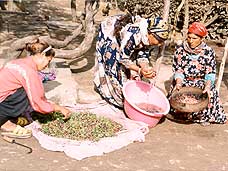|
Women and Biodiversity
Women are very closely involved with development and environment in North Africa. They are dependent on the natural environment for their basic needs and hence are the main sufferers when the environment is degraded and resources diminished. Women are the producers of fifty percent of food and are the primary users of medicinal plants, fuel wood and water as agriculturists and household managers. In rural areas, women contribute sixty to eighty percent of their labor force to farm activities. In their process of producing goods for themselves and their families, fetching fuel wood and water, tilling the land and treating illness, women, particularly in rural areas, use natural resources and are constantly faced with the challenge of managing environment and food crisis.

Despite their involvement in work outside of the domestic sphere, their work is viewed socially as secondary. Women are often absent from the process of decision-making and only rarely gain access to means of production, to land, to credits and to an equitable remuneration of their work.
However, their double role in the management of the family circle and of the environment is crucial to achieving sustainable development. This is why a main focus of the North Africa Biodiversity Programme was on women initiatives. The aim was to increase the awareness of women to conservation, to acknowledge them as a source of indigenous knowledge, to develop their capacities and to increase their revenue through a better management of natural resources.
At a regional level, the Programme sought the creation of a regional network of women and produced a gender newsletter. An introductory training on gender involvement in development activities took place at the regional level. At the national level, each country had different activities within this framework, based on specific programme initiatives.
|


